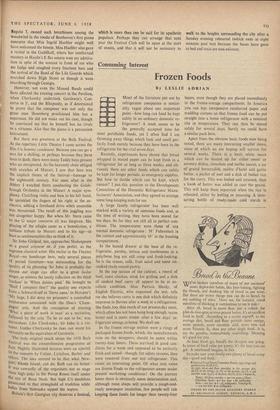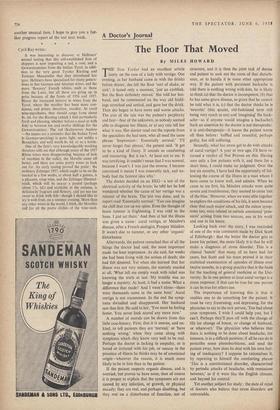Consuming Interest
Frozen Foods
By LESLIE ADRIAN Recently, experiments have shown that bread wrapped in waxed paper can be kept fresh in a refrigerator for as long as three weeks; and ob- viously there are other foods which can safely be kept for longer periods, as emergency supplies. But how to decide which can be kept, which cannot? I put this question to the Development, Committee of the Domestic Refrigerator Manu- facturers' Association, and they agreed to arrange some long-keeping tests for me.
A large family refrigerator has been well stocked with a variety of common foods and, at the time of writing, they have been stored for ten days. So far they are still all in perfect con- dition. The temperatures were those of any normal domestic refrigerator : 38° Fahrenheit in the cabinet and approximately 10° in the freezing compartment.
In the humid drawer at the base of the re- frigerator, parsley, lettuce and mushrooms in a polythene bag are still crisp and fresh-looking. So is the cream, milk, fruit salad and some un- cooked ready-mixed pastry.
In the top section of the cabinet, a round of beef, roast chicken, steak for grilling and a dish of cooked beef curry all appear to be in ex- cellent condition. Miss Patricia Hardy, of English Electric, who organised the test, tells me she believes curry is one dish which definitely improves in flavour after a week in a refrigerator. She finds, too, that much of our presentrday meat, which often has not been hung long enough, tastes better and is more tender after a few days' re- frigerator storage at home. We shall see.
In the frozen storage section were a range of packaged frozen foods, which, the manufacturers state on the wrappers, should be eaten within twenty-four hours. These survived in good con- dition for a week and appeared to be perfectly fresh and sound—though, for safety reasons, they were removed from our test refrigerator. This raises an interesting point. Of what real value are frozen foods to the refrigerator-owner under present marketing conditions? On the journey home there is obviously some deterioration and, although most shops will provide a rough-and- ready newspaper insulation, few people will risk keeping these foods for longer than twenty-four hours, even though they are placed immediately in the frozen-storage compartment. In America you can buy inexpensive reinforced paper and wadding cartons so that frozen food can be put straight into a home refrigerator with a minimal ,rise in temperature. They can then be stored safely for several days. Surely we could have a similar pack here.
Apart from the obvious basic foods now being tested, there are many interesting smaller items, some of which we are hoping will survive for several weeks. There is a basic white sauce which can be heated up for either sweet or savoury dishes, chocolate and melba sauces, a jar of grated horseradish, maitre d'hotel and garlic butter, a packet of suet and a dish of boiled rice for the curry. This was boiled and strained, then a knob of butter was added to coat the grains. This will keep them separated when the rice is reheated, either by boiling or steaming. A time- saving bottle of ready-made cold starch is another unusual item. I hope to give you a fur- ther progress report of the test next week.
Cyril Ray writes : It was interesting to discover at Hellmers' annual tasting that this old-established firm of shippers is now importing a red, a rosé, and a Gewurztraminer from the Italian Tyrol, in addi- tion to the very good Tyroler Riesling and Terlaner Muscateller that they introduced last year. Hellmers have specialised for many genera- tions in fine German and Alsatian wines, and the more 'flavoury' French whites, such as those from the Loire, but all these are going up in price because of the frosts of 1956 and 1957. Hence the increased interest in wines from the Tyrol, where the, weather has been more con- sistent, and prices, therefore, steadier. At retail wine-merchants, they should range from about 8s. 6d. for the Riesling (which I find particularly fresh and pleasing, whether before a meal or with fish) to between, ten and twelve shillings for the Gewurztraminer. The red (Kalterersee Auslese —the names are a reminder that the Italian Tyrol is German-speaking) is quite light, not unlike a Beaujolais, and well worth 8s. 6d. or so a bottle.
One of the firm's very knowledgeable working directors tells me that although many of the 1957 Rhine wines were disappointing, because of lack of sunshine in the valley, the Moselle came off better, and there are some pretty wines to look out for. An early tasting proved the point : the ordinary Zeltinger 1957, which ought to be on the market in a few weeks, at about half a guinea, is a pleasant, crisp wine, and the Zeltinger Himmel- reich, which will be nearer a pound (perhaps about 17s. 6d.) and available in the autumn, is deliciously fragrant and flowery, and yet not too sweet to drink with fish—though I should like to try it with fruit, on a summer evening. More than any other wines in the world, I think, the Moselles call for all the poetic clichés of the wine-snob.











































 Previous page
Previous page